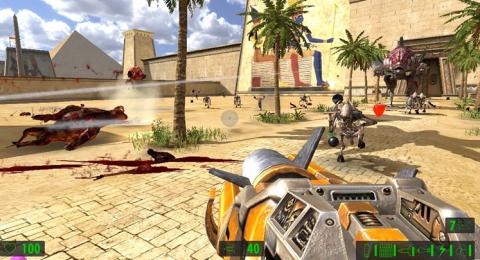
It was only a matter of time before the benchmark wars between nVidia's GeForce FX and ATI's Radeon 9700 PRO would begin. The only reason that held some sort of truce between the two graphics rivals was the fact that no one could get their hands on a GFX based board.
According to Maximum PC magazine's February issue the calm before the storm is officially over. The magazine claim to have had the pleasure of possessing, for a short while, a beta version of Alienware's upcoming GFX based board.
Initially, nVidia played coy and did not want to allow the magazine to publish any benchmarking results, claiming that the chip was a beta version and that the drivers were far from ready for high-powered tests. They finally accepted the publication of the results of a few tests at pre - approved benchmarks running at nVidia specified resolutions and settings. According to nVidia the final product, which is expected to retail in late February or March, will be far more refined than the version tested by Maximum PC.
Before we go into the numbers produced by the tests here is a little recap of what GeForce FX has to offer: pixel and vertex shaders that exceed the DirectX 9 specifications, 128-bit floating-point precision throughout the 3D pipeline, and support for DDR II memory.
Quake III
Quake III running at 1600x1200, 32-bit color and 2x anti-aliasing, GeForce FX proved to be 40 per cent faster than the ATI Radeon 9700 PRO at the same settings.
UT 2003
GFX was 20 per cent faster than ATI's 9700 PRO in the Unreal Tournament 2003 Asbestos fly-by demo at the above mentioned settings.
3D Mark 2001:SE
The suprise came from the 3DMark 2001:SE Game 4 benchmark, again at the same settings, at these settings, there the Radeon 9700 was 10 per cent faster than GeForce FX.
The detailed results are as follows:
GeForce FX
Quake3 Demo001, 1600x1200 2xAA: 209fps
UT 2003 Asbestos, 1600x1200 2xAA: 140fps
3DMark Game4, 1600x1200 2xAA: 41fps
Radeon 9700 Pro
Quake3 Demo001, 1600x1200 2xAA: 147fps
UT 2003 Asbestos, 1600x1200 2xAA: 119fps
3DMark Game4, 1600x1200 2xAA: 45fps
What these tests prove beyond doubt is that in most cases GFX will be quite a bit faster than the 9700 PRO. ATI will of course argue that their card was targeted at the High-End of the GF 4 market rather than the GFX but that will mean that they will have to dennounce their got there first claims and accept that they will have to wait until their next chip in order to compete with the GeForce FX.
nVidia on the other hand will also claim that memory bandwidth will not be an issue, as these tests hint, when the refined, retail product appears on store shelves and is accompanied by similarly improved drivers. They will also have to accept however, that the release of this product has been delayed enough for ATI to prepare their next generation chip, probably .13 and DDR II, which at the current rate may be announced before GFX reaches consumers.








